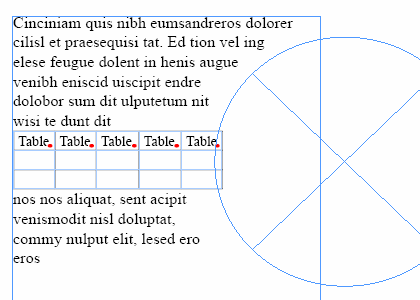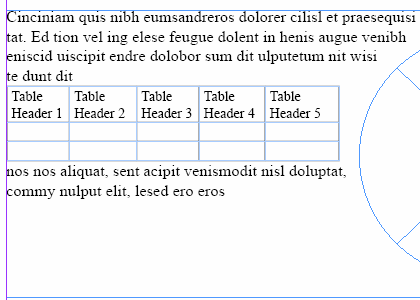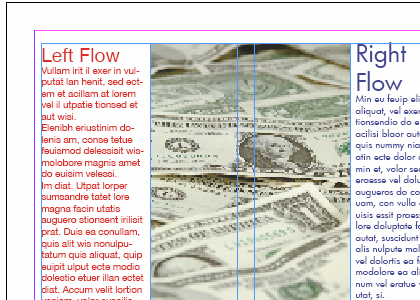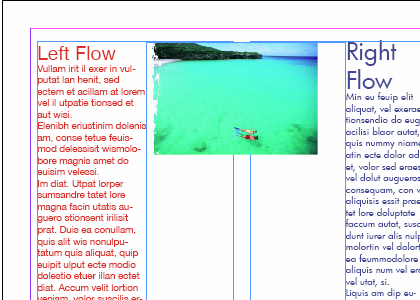Professional authoring environments give designers the possibility of applying fitting strategies to the
content. These fitting strategies usually involve either fitting the content to the frame or fitting the
frame to the content. When this second option is selected, the frame is either expanded or reduced from
its original size and left where formally placed in the document. This is mainly because the page design
is intended to be executed by the designer, which will adjust the surrounding elements to best fit the
content driven adjusted frame.
In the case of automatic rendering, the possibility of fitting the FO region to the content can be as
appealing as fitting the content to the region. However it is important that the rendering engine
automatically considers the neighbor regions to provide an aesthetically pleasing result.
In order to do this, some extension to the regions could be introduced allowing the expression of spatial
relationships between some of the regions. In this way a designer can define the ranges in which the
content driven regions can expand or contract and also the required surrounding region adjustments.
This adds the benefit of ensuring a designer controllable result as well as controlling the finite number
of steps in computing the possible combinations.
2.8.10.1 Use cases
The content driven adjustable page masters uses the proposed XSL-FO 2.0 complex page master model,
using SVG to express non-rectangular regions. An example of facing non rectangular areas can be:
<fo:complex-page-master master-name="only" page-height="29.7cm" page-width="21cm" margin-top="1cm"
margin-bottom="2cm" margin-left="2.5cm" margin-right="2.5cm">
<fo:region-arbitrary region-name="circle" content-type="image/svg+xml" z-index="2"
width="150pt" height="150pt" top="50pt" left="50pt">
<svg:svg xmlns:svg="http://www.w3.org/2000/svg" width="100%" height="100%">
<svg:circle cx="240" cy="200" r="200" />
</svg:svg>
</fo:region-arbitrary>
<fo:region-arbitrary region-name="square" content-type="image/svg+xml" z-index="1"
width="100pt" height="100pt" top="50pt" left="200pt">
<svg:svg xmlns:svg="http://www.w3.org/2000/svg" width="100%" height="100%">
<svg:rect width="100" height="100" />
</svg:svg>
</fo:region-arbitrary>
</fo:complex-page-master>
The rendered results is illustrated below.

A first instance of the use case illustrates a small table with two columns. In this situation the
content fits perfectly within the assigned region. Increasing the table size by adding more columns,
e.g. five, substantially changes the re-flowing capabilities of the content. More horizontal space it
is now required.

No matter what the composition engine is trying to do this will produce a horizontal overflow.
If the regions are flexible and they can adjust their size and position relative to each other, the
rectangular region can grow in width and the circle region can shift leftwards, thus preserving a
similar text runaround ratio.
The resulting effect is illustrated in the figure below.

A possible markup notation to address this behaviour is to leverage the optimum, minimum and maximum
subproperties for dimension and/or positions and a function to retrieve dimensions and/or positions
from other regions within the page.
The following example illustrates the concept.
<fo:complex-page-master master-name="only" page-height="29.7cm" page-width="21cm" margin-top="1cm" margin-bottom="2cm" margin-left="2.5cm" margin-right="2.5cm">
<fo:region-arbitrary region-name="circle" content-type="image/svg+xml" z-index="2" width="150pt" height="150pt" top="50pt" left="200pt+(from-region-width('rectangle')-100pt)">
<svg:svg xmlns:svg="http://www.w3.org/2000/svg" width="100%" height="100%">
<svg:circle cx="240" cy="200" r="100%" />
</svg:svg>
</fo:region-arbitrary>
<fo:region-arbitrary region-name="rectangle" content-type="image/svg+xml" width.optimum="100pt" width.minimum="100pt" width.maximum="200pt" height="300pt" top="50pt" left="50pt" z-index="1">
<svg:svg xmlns:svg="http://www.w3.org/2000/svg" width="100%" height="100%">
<svg:rect width="100%" height="100%" />
</svg:svg>
</fo:region-arbitrary>
</fo:complex-page-master>
Every time the content fails to fit a given region, and subsequently produces overflow, the page
flexibility mechanism is activated. Another factor to be taken into consideration is the aspect ratio
of images. Layout adjustment can be more complex involving than only facing regions and can act
according to the width, height, position and run-around effects.
The following figure presents a case with two separate flows and a region containing an image
producing a runaround.


If the image changes considerably in size and aspect ratio, the entire design is badly affected.
If the page regions can adjust their sizes and reposition themselves, it is possible to obtain a
neater result, as shown in the next illustration

The region has resized itself following the image content size and it has maintained the relative
center of the original region.
A possible mark-up notation to achieve this can be:
<fo:region-arbitrary region-name="image-region" content-type="image/svg+xml" z-index="2" width="from-content-width()" height="from-content-height()" top="10pt+(from-content-height() div 2)" left="90pt+(from-content-width() div 2)">
<svg:svg xmlns:svg="http://www.w3.org/2000/svg" width="100%" height="100%">
<svg:rect width="100%" height="100%"/>
</svg:svg>
</fo:region-arbitrary>
The proposed solution can be achieved by introducing in the format two new types of functions. The first
type gather sizes from the region content itself meanwhile the second enables a cross reference between
regions within the page. In addition, a concept of min, max and optimum can be leveraged, from existing
paradigms, to provide size ranges.






